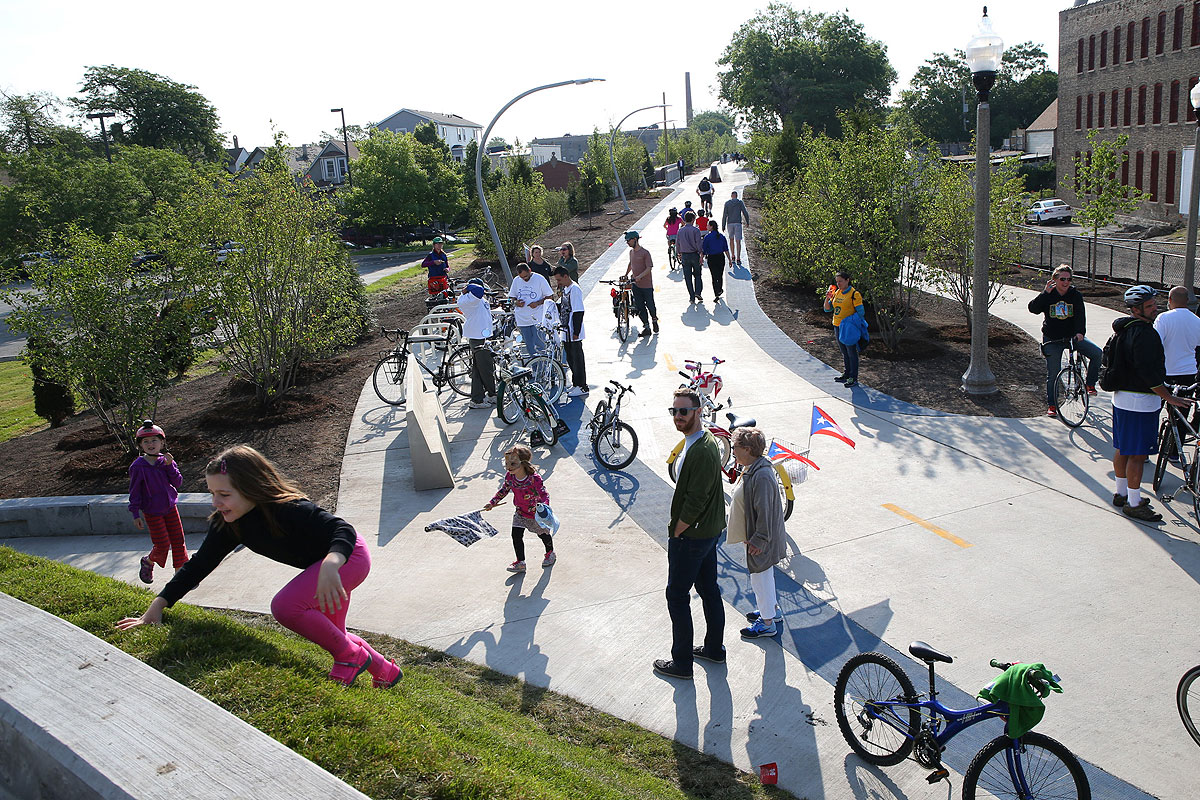For the past few years, Chicago's parks have been one of the most interesting subjects to cover in the city. The 606 opened, bringing a new form of park to the city. The Riverwalk became a full-fledged entity, and is nearing completion, turning the city's old industrial channel into a recreational corridor. The city opened four boathouses along the river to encourage its use beyond downtown. The huge, bike-centric Big Marsh park on the far South Side opened late last year.
A year after the mayor announced the Building on Burnham initiative, though, there are headwinds. The state is going on two years without a budget, which put a hold on parks grants throughout the state for over a year. The Trump administration's "skinny budget" proposal—though still early in the process—bodes ill for transportation and environmental funding, both of which the city leveraged to construct the 606 and Riverwalk. The Tribune's Mary Wisniewski just reported that the city is using "alternative sources" to complete the funding for the 41st Street pedestrian bridge after a conflict with the state over the final $2 million—with the rest coming from the state and, in the largest chunk, federal grants. Could Trump's austerity budget slow down the greening of the city?
"The honest answer is yes, I'm nervous," Rahm Emanuel told me at City Hall last week. "I don't believe his budget's going to make it, but I think the things we rely on are going to be under severe stress. We're going to have to be more creative and more forceful. The truth is, we couldn't do a Riverwalk today under what's going on."
The mayor noted that nearly 60 percent of the money used to complete the 606 project came from the Congestion Mitigation and Air Quality Improvement program, which is run by the Federal Highway Administration. "You couldn't do that under [Trump's] budget. That's how you have to think about this now," he said.
A couple of the city's forthcoming park projects rely on private money. The reopening of the renovated Theater on the Lake as a year-round venue involves $5.9 million to restore the building from the company that will operate it, which will also pay an additional $2.8 million to the Park District in revenues from the theater and restaurant. The separation of the lakefront trail's pedestrian and bike paths is supported by a $12 million donation from hedge-fund billionaire Ken Griffin. The private XS Tennis facility, which works with Chicago Public Schools, is expanding with $2.9 million in TIF money and $200,000 in private investment that the mayor helped secure.
"We've been conditioned for quite awhile to survive without the state's help," says Park District commissioner Michael Kelly. "But we do need IDNR [Illinois Department of Natural Resources] funds, we do need those DCEO [Department of Commerce and Economic Opportunity] investments. If we're raising money for a fieldhouse, we identify the needs, we identify the scope of the work and the cost, and the park district will say, we're in for the last third. Now we collectively—the we being the neighborhood, the park district, and the leadership—raise the other two-thirds. TIF has been great for us, aldermanic menu money has been good at times, and the state grants. Those are the sources. We hope one day federal earmarks come back, state earmarks come back. Those are what got a lot of projects done for us in the early 2000s."
The Park District is also collaborating with Chicago Public Schools on a sports program open to all comers (who can't be cut from their teams) from 5th through 8th grades, in essence a citywide rec league that's more about participation than competition. Kelly says the program, called SCORE and sponsored by donors including World Sport Chicago and the Blackhawks, served 9,000 kids in basketball this winter.
"Now we move on to track and field, girl's soccer, and field hockey," Kelly says. "I'm particularly looking for a resurgence in track and field coming out of Chicago."
While the Park District has received a lot of attention for its major projects, it has increased program enrollment from almost 200,000 in 2011 to just over 400,000 in 2016, according to the agency's numbers. Part of that increase was aided by proper data collection to determine which demographics needed to be served. "When I took over in 2011, the park district … recorded its data on paper, if at all. When we took over we started automating and digitizing how we collected our data," Kelly says. "We could see where our holes were."
But the district also wants to increase its space. The Building on Burnham initiative set a goal for the city to have 2,020 acres of natural areas by 2020. Last year the city added 182 acres, bringing the total to 1,606. "We didn't make the pledge without some rough estimate of how to get there," Emanuel says.
Those natural areas are distinct from what people usually think of when it comes to parks.
"It happened, in some respects, so subtly that people didn't even know it. All that parkland south of McCormick Place, on both sides of Lake Shore Drive, was just typical mowed grass. [We] mowed it every day, and very few people were out in a lot of those spots; we were just throwing more emissions into the atmosphere," Kelly says. "So we made a conscious decision to turn it into natural area."
He sees the initiative as a long-term way to remake the city. "We're the green agency, and we're really the green fabric of Chicago. Because of industry and manufacturing leaving Chicago, which is terrible, it's an opportunity for the city to rebuild itself around parkland," Kelly says.



